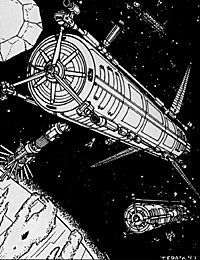These are megastructures that depend on the presence of a planet for construction.
 Orbitville
Orbitville
This a solid ring constructed around a planet in orbit. Usually they are associated with one or more space elevators, and may be a natural outgrowth of that technology. After all, only devices like the elevators would make it feasible to move all the material to and from the planet needed for construction.
Like the O'Neil colony, an orbitville has only one main purpose: living space, A ring with a radius of 40,000 km, a width of 100 km, and a thickness of one km would have a volume of nearly 12.5 million cubic kilometers. It could literally hold billions of inhabitants if self-sufficient, more if food is imported.
An orbitville could also have important secondary functions. It could provide the owning world with enormous orbital manufacturing capabilities (the megastructure could be entirely automated and dedicated to, say, processing asteroids that are brought to it), as well as some very impressive defense capabilities (the megastructure could hold lots of missile ports and laser batteries).
Orbitvilles are mentioned in the last chapter of The Fountains of Paradise and in Clarke's novel 3001: Final Odyssey. One can also be seen in the opening sequence of the anime film, Dirty Pair: The E.D.E.N. Project.
Space Elevator
This is an incredibly high tower that extends beyond the atmosphere many tens of thousands of kilometers into space.
The principle is simple. Tie a string to a baseball and twirl the string above your head. The string will remain taut and straight as long as the twirling motion is in effect. The Earth is spinning far faster than your hand could ever manage, about 1000 miles per hour. If you anchored an incredibly strong wire to Earth's surface at the equator, then attached the other end to a large enough mass (say, a small asteroid) to keep it taut, you end up with a perfectly-straight railroad track right into space.
A space elevator built on Earth would have to measure approximately 40,000 kilometers long in order for it to operate with minimal structural stress. A fully- operational one could be from 100 to 1000 meters thick, and have a constant stream of cargo and passenger pods going up and down. Traveling an average of 1000 km an hour, it would take about two days to travel from the surface to the anchoring asteroid.
The advantages of such a system are enormous. Interface travel from surface to space would be reduced to pennies a ton for cargo, or a rate equivalent to a passenger train for human riders. A space elevator located on a world with a lot of space traffic would pay for itself in a few decades. If the anchoring planet has a strong magnetic field; a series of superconductor cables running the length of the elevator could supply a great deal of the megastructure's operating energy as it moves through the magnetic field, generating electric current.
The builders could even make money by selling the delta-V of the space elevator to outbound ships, "flinging" them from the anchoring asteroid into space much like an oversized Rotovator (see above) .
But a space elevator also comes with some limitations. It must be located exactly on the planet's equator, and on some worlds there may be no appropriate land mass there. It also requires advanced materials technology; the elevator, especially during construction, will have to endure stresses that are far beyond anything known in the late 20th century. And in game universes where there is cheap anti-gravity (Traveller, Star Trek), a space elevator could prove to be economically impractical.
The very best example of a space elevator comes from an old game supplement put out by GDW for their late, lamented 2300 AD game, called Beanstalk. It contains diagrams and charts, very detailed information, and three adventures centered around a space elevator on a colony world. The novel The Fountains of Paradise, by Arthur C. Clarke, chronicles the enormous task of constructing a space elevator.
MegaStructures Sci-fi Settings That Challenge the Scale of the Universe
- Introduction
Free-Floating Structures
Planet-Centric Structures
Star-Centric Structures
Other Genres
Back to Shadis #39 Table of Contents
Back to Shadis List of Issues
Back to MagWeb Master List of Magazines
© Copyright 1997 by Alderac Entertainment Group
This article appears in MagWeb.com (Magazine Web) on the Internet World Wide Web.
Other military history articles and gaming articles are available at http://www.magweb.com